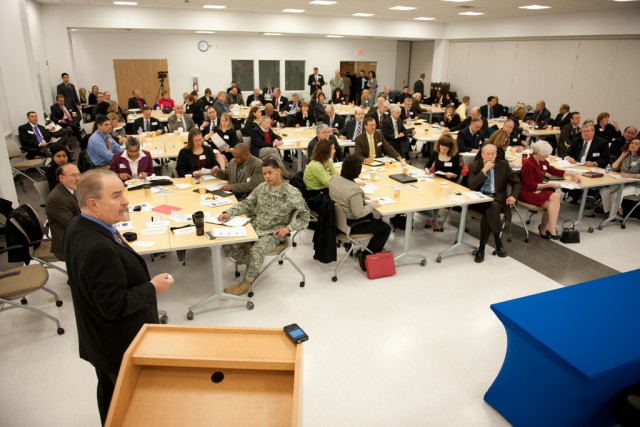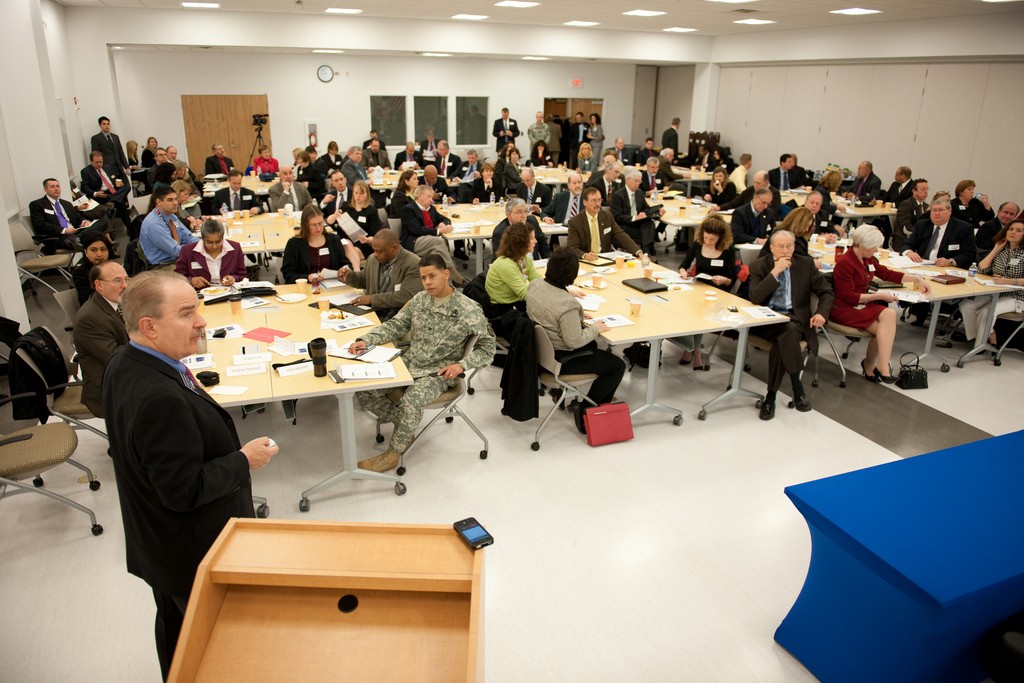ABERDEEN PROVING GROUND, Md. (Feb. 14, 2011) -- Area education, government and industry leaders gathered here Feb. 11 to convene the first of what is expected to be a series of summits on science, technology, engineering and mathematics, or STEM education.
"Our real focus is to bring the community together, organize ourselves and find the way to keep the momentum behind our STEM initiatives in the area," Mr. Gary Martin, executive deputy to the commanding general, Research, Development and Engineering Command, said at the summit.
The conference centered around four panels -- government, industry, K-12 education and higher education -- discussing the successes, gaps and challenges with their respective STEM programs.
The government panel, consisting of representatives from several organizations at Aberdeen Proving Ground, relayed the numerous outreach efforts available for STEM education.
"Our job is to provide long-range learning opportunities for kids so they are ready to pursue the challenging math and science courses," Dr. Katie Blanding, STEM outreach coordinator for RDECOM, said.
"First off, we have a willing body of people on post with programs that engage both on and off the installation. Second, we have facilities. Third, we have opportunities for teachers and students to spend time with us both in the schools and on the installation," Martin said.
The industry panelists conveyed how STEM is seen by them through the prism of workforce development.
"We see STEM as our life blood," Glen Bassett, Site Executive and Director of Advanced Communications and Countermeasures, Raytheon, said.
"With corporate involvement, we look for short-term goals. But when you are talking about education, it is really a long-term pursuit," Nicole Funk, Senior Vice President, Booz Allen Hamilton, said.
Funk also commented on how STEM has begun to become ingrained in the culture of students, educators and industry.
"STEM is growing fast. I think every place I go, I hear about it. A lot of programs are adding STEM to the conversation," she said.
The education panelists reiterated the change they are witnessing in the perception of STEM education and its participants.
"APG has provided a destination for the kid who aspires in STEM subjects. We're creating a culture with long-term goals ahead," Dr. Jeffrey Lawson, executive director for high school education in Cecil County said.
Dr. Stephen Pannill, president of Cecil College, led the higher education panel and continued on that theme by expressing the need to celebrate students and professionals who excel in STEM, rather than pop culture icons.
"We need to highlight the heroes in the STEM fields and make them as important and significant to folks as our sports heroes," he said.
Pannill's comments echo remarks made by President Barack Obama during last month's State of the Union address. During his speech, Obama said, "We need to teach our kids that it's not just the winner of the Super Bowl who deserves to be celebrated, but the winner of the science fair."
As the summit drew to a close, Martin stressed the need to continue similar summits in the future to build on previous achievements.
"The intent here isn't simply to just have one meeting and then walk away and call that success. We'll have some follow-up activities and we will continue the dialogue," he said.
Martin then laid out his plan for the next summit. He requested volunteer team leaders for four workgroups: lighting the spark, teacher enrichment, curriculum enhancement and strategic communications. After team leaders were assigned, attendees were invited to sign up and join one of the workgroups with an eye toward the next summit.
"We'd like the groups to get together and have some discussion on how to normalize the data we've heard here. Then, perhaps, come to the next summit with recommendations on what we should collectively do," Martin said.
The next STEM summit has been tentatively scheduled for Apr. 28.


Social Sharing